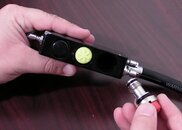TRIBOLUBE71
Contributor
discolored grease in MK 25
I have looked at the picture quite a few times, and I would prefer to have the part in here for analysis and testing.
I have seen this phenomenon many times on stainless steel and other metallurgical substrates. Other materials will also be affected. For instance, have you ever opened your regulator and seen a bluish purple hue in the normally bright white grease? Evidence indicates this color change originates directly from various o-rings used. This can happen in static and dynamic application areas that have been lubricated with the standard C-lube MCG129 grease. This reaction does not appear to be attributed to the neat version of the grease (only PFPE oil and PTFE thickener), but the corrosion inhibitor additivated in the grease. There is a possibility that Lewis Acids are present from the freshly rubbed metal surface. Lewis Acid is extremely caustic and will affecting every component within the system. Historically when this system has been compromised by Lewis acid, HF (hydrogen fluoride) gas, or PFOA (perfluorooctanoic acid) the fluorinated molecular chain in the PFPE oil is destabilized. Depolymerization or unzipping of the fluorinated chain breaks the bonds of polymers into a monomer structure as a result. Real world the backbone of the grease breaks down leading to corrosion and inevitable failure of the oil in the grease. I know this is a technical explanation, but this is the best way to describe this process. Mechanically and chemically this is often the cause corrosion and discoloration due to degradation of the original grease structure. Positive determination would require testing of the part in the picture.
My effort is to deliver an accurate explanation, and be a resource to divers and the scuba industry. I hope this is helpful, and answers your questions.
I decided to attach a photo showing how a part can be protected from corrosion. This is a high pressure manifold block made of aluminum, where stainless valves are inserted. One of the valves has been removed for inspection. This might not seem important until we add that the valve was only treated once with Tribolube® EPO2 just shy of two years ago. There was an ongoing problem when same grease in your MK 25 was used in this part. There was so much galvanic corrosion; the engineer said it took a wrench and a torsion bar to remove the valve. When Tribolube® EPO2 was properly applied to the valve (even without any grease), the part unscrewed without incident according to the engineer once loosened he unscrewed it “with just one finger”.
*We still recommend using Tribolube® 71 lubricant after treating the part with Tribolube® EPO2

I have looked at the picture quite a few times, and I would prefer to have the part in here for analysis and testing.
I have seen this phenomenon many times on stainless steel and other metallurgical substrates. Other materials will also be affected. For instance, have you ever opened your regulator and seen a bluish purple hue in the normally bright white grease? Evidence indicates this color change originates directly from various o-rings used. This can happen in static and dynamic application areas that have been lubricated with the standard C-lube MCG129 grease. This reaction does not appear to be attributed to the neat version of the grease (only PFPE oil and PTFE thickener), but the corrosion inhibitor additivated in the grease. There is a possibility that Lewis Acids are present from the freshly rubbed metal surface. Lewis Acid is extremely caustic and will affecting every component within the system. Historically when this system has been compromised by Lewis acid, HF (hydrogen fluoride) gas, or PFOA (perfluorooctanoic acid) the fluorinated molecular chain in the PFPE oil is destabilized. Depolymerization or unzipping of the fluorinated chain breaks the bonds of polymers into a monomer structure as a result. Real world the backbone of the grease breaks down leading to corrosion and inevitable failure of the oil in the grease. I know this is a technical explanation, but this is the best way to describe this process. Mechanically and chemically this is often the cause corrosion and discoloration due to degradation of the original grease structure. Positive determination would require testing of the part in the picture.
My effort is to deliver an accurate explanation, and be a resource to divers and the scuba industry. I hope this is helpful, and answers your questions.
I decided to attach a photo showing how a part can be protected from corrosion. This is a high pressure manifold block made of aluminum, where stainless valves are inserted. One of the valves has been removed for inspection. This might not seem important until we add that the valve was only treated once with Tribolube® EPO2 just shy of two years ago. There was an ongoing problem when same grease in your MK 25 was used in this part. There was so much galvanic corrosion; the engineer said it took a wrench and a torsion bar to remove the valve. When Tribolube® EPO2 was properly applied to the valve (even without any grease), the part unscrewed without incident according to the engineer once loosened he unscrewed it “with just one finger”.
*We still recommend using Tribolube® 71 lubricant after treating the part with Tribolube® EPO2

Sure that is not the Weicon anti seize "hi-tech"?



